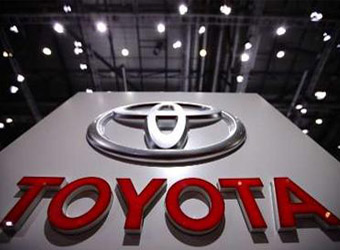Toyota Motor Corp. (7203), the world’s largest automaker, raised its full-year profit forecast by 13 percent as the weaker yen boosted earnings from Prius and Lexus vehicles exported fromJapan.
Net income will probably rise to 1.67 trillion yen ($16.9 billion) in the year ending March 31, the Toyota City, Japan-based carmaker said in a statement today. That compares with the previous forecast of 1.48 trillion yen and the 1.82-trillion-yen average of 22 analyst estimates compiled by Bloomberg.
Toyota earned more profit than General Motors Co. (GM) andVolkswagen AG (VOW) combined last quarter, helping restore confidence in the idea that Prime Minister Shinzo Abe’s policies, which have helped the yen weaken against every major currency in the past year, are giving Japanese exporters an edge. Optimism about Abenomics had been wavering this earnings season at Japan Inc. as companies from Sony Corp. (6758) to Nissan Motor Co. (7201) cut their profit forecasts.
“Toyota is the company that’s benefited most from Abenomics because of the currency,” said Takaki Nakanishi, founder of industry research firm Nakanishi Research Institute and the top ranked auto analyst by Institutional Investor magazine. “The prime minister will probably say this is a win for Abenomics, that his direction is right and that Toyota’s earnings are good proof.”
Falling Yen
Toyota rose 0.5 percent to close at 6,350 yen in Tokyo before reporting results, compared with the 0.8 percent advance by the Nikkei 225 Stock Average. The stock has gained 59 percent this year.
The yen has fallen about 12 percent against the dollar in 2013, helped by Abe’s monetary easing policies. The currency traded at an average of 99 yen last quarter, a decline of 20 percent from a year earlier.
Toyota based its financial forecasts on a level of 97 yen to the dollar and 130 yen to the euro. Every one-yen decline boosts operating income by about 40 billion yen at Toyota, compared with 15 billion at Nissan, the companies said in May.
Toyota’s results come amid waning optimism over Japanese carmakers. Last week, Honda Motor Co. (7267) reported second-quarter earnings that missed analysts’ estimates and Nissan cut its annual profit forecast. The yen is becoming decreasingly volatile in recent months, with the exchange rate stabilizing to between 97 and 99 against the dollar.
Yen’s Reversal
“In the past couple of months we could say the weak yen have pushed up profits of the carmaker,” said Yuuki Sakurai, chief executive officer of Fukoku Capital Management Inc. “I don’t think it will keep weakening, and we may even see a strong yen if the U.S. economy doesn’t improve very much.”
Before Abe, the Japanese currency hobbled exporters for years, appreciating to a postwar high of 75.35 to the dollar in October 2011 from about 115 four years earlier. The yen began tumbling in late 2012 as polls showed Abe, who called for unprecedented monetary-easing policies that would weaken the currency, was going to be Japan’s next head of state.
The yen’s benefits were most visible in Toyota’s earnings from Japan, the company’s biggest export base. Operating profit from its home country more than doubled to about 374 billion yen, compared with 363.3-billion-yen average analyst estimate.
“The weak yen and cost-cutting are the two main reasons for Toyota’s recovery in profit in Japan compared with a year earlier,” said Issei Takahashi, a Tokyo-based auto analyst at Credit Suisse Group AG. “They should be able to maintain the current profit level if the currency rate remains stable.”
Looming Tax
The automaker is also getting a short-term boost in Japan as consumers rush to buy cars before an increase in the consumption tax in April, according to Koji Endo, an auto analyst at Advanced Research Japan in Tokyo.
In North America, Toyota reaped 79.6 billion yen in operating profit last quarter, increasing from 65 billion yen a year earlier. That compares with the 96 billion-yen average estimate of four analysts surveyed by Bloomberg.
In the U.S., deliveries rose 12 percent in the period as the weaker yen gave Toyota room to offer higher incentives for its best-selling Camry model. The company outsold Ford Motor Co. for the first time in 15 quarters.
Operating profit in Europe rose more than doubled to 20.1 billion yen, compared with the 9.5-billion yen average analysts’ estimate, amid mounting signs that the region is recovering from its record six-quarter recession. In September, European car sales rose the most in more than two years.
Bottoming Europe
“The story is the market has bottomed in Europe,” said Chotai. “So there’s no more declines, but certainly you can’t expect strong growth.”
In Asian markets — excluding Japan — operating profit slipped to 91.4 billion yen, dragged down by a slump in demand in Thailand. Toyota’s deliveries plunged about 30 percent to 96,000 units in the Southeast Asian country as government rebates ended for first-time car purchases.
“Toyota is a market leader in Southeast Asia so there’s much stronger headwinds for them,” said Ashvin Chotai, managing director of Intelligence Automotive Asia in London. “The outlook in Thailand will remain quite weak in the next 12 months mainly due to the lack of pent-up demand. It’s also certainly hard to be optimistic about Indonesia — it’s a market which is always gonna be volatile.”
Toyota sales in China, the world’s largest auto market, rose at the fastest pace in five quarters as it rebounded from last year, when nationwide protests erupted in opposition to Japan’s purchase of a group of islands claimed by both countries.
“There’s some room for upward surprise in China, as long as there’s no escalation of tensions,” said Ashvin Chotai, managing director of Intelligence Automotive Asia in London. “The overall market is growing faster than people expected in the beginning of the year so the pie is bigger. Still, for Japanese carmakers there’s a long road ahead.”
Source: Bloomberg
